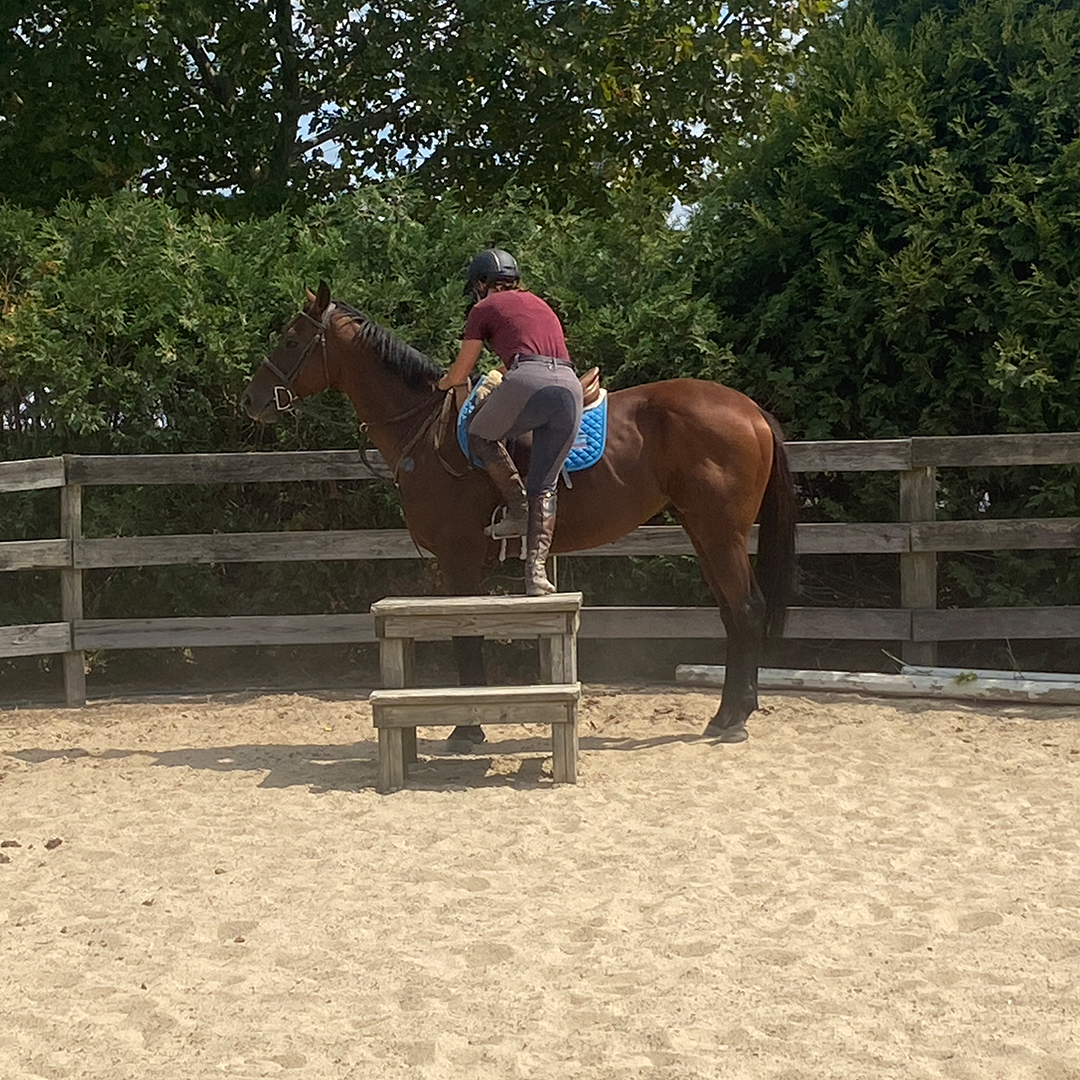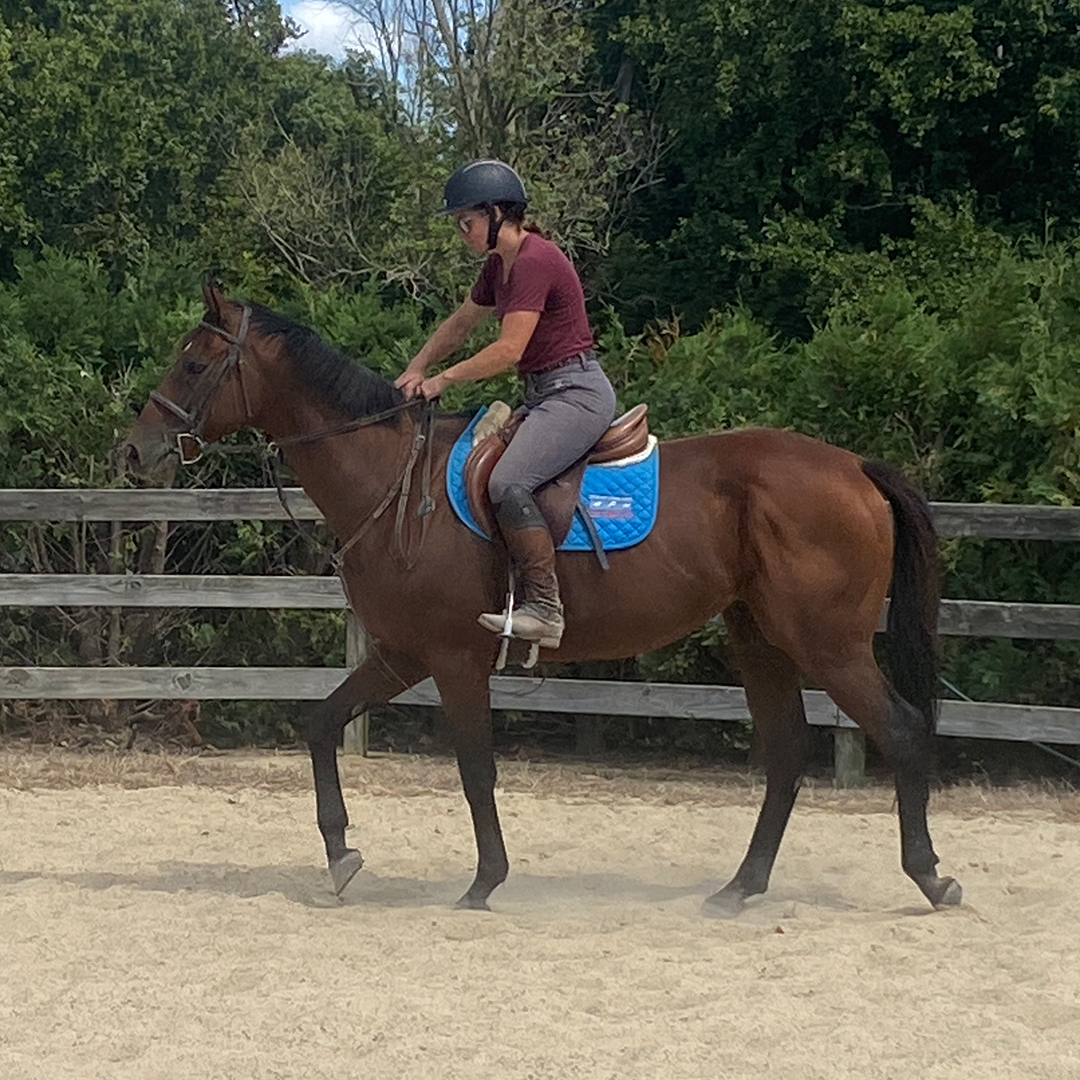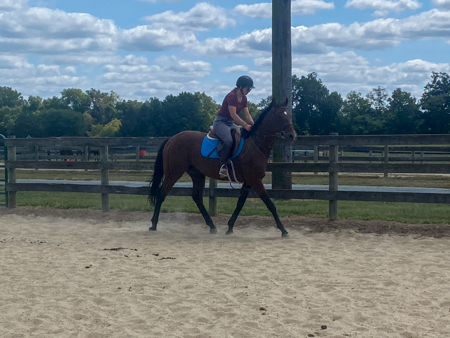More results...
The First Ride
The First Ride
By: Alexis Arbaugh

The first ride on a recently retired Thoroughbred racehorse can be quite daunting, especially for those new to it. Even experienced riders might find it intimidating. These horses are fresh off the racetrack, often highly muscled, fit, and powerful—qualities that make them incredibly fast and strong but also a bit overwhelming for immediate riding. Most owners give their retired racehorses a break before starting any retraining. This downtime allows the horse to relax, adjust to its new environment, and lose some of that racetrack muscle. It is crucial for starting the retraining process with a clean slate.
Thoroughbred Aftercare Alliance had the pleasure of speaking with Beverly Strauss, one of the co-founders of MidAtlantic Horse Rescue in Chesapeake City, Maryland, about the first ride off the racetrack. MidAtlantic, a Thoroughbred Aftercare Alliance-accredited organization, cares for more than 45 horses across their main facility and satellite farms. They work closely with racetracks to take horses directly off the track and rescue them from auctions and feed lots. Once the horses arrive, they are carefully evaluated for rideability, trained, and placed into adoptive homes. In addition to her aftercare work, Bev and her husband run a small Thoroughbred racing business at Delaware Park. With her extensive knowledge both on and off the racetrack, Bev is a highly skilled horsewoman who ensures the best outcomes for all her horses.
“One of the great things about OTTBs is the solid foundation that most of them have,” Bev wrote. Many are already well-versed in walking, jogging, cantering, galloping, and automatically changing leads, both independently and in groups. These young Thoroughbreds are exposed to a lot of commotion during early morning workouts and race days, learning to stay relaxed even in busy environments. Whether they race for ten years or not at all, they come away highly desensitized.
There are a few key similarities between racehorse riding and sport horse riding. In both disciplines, riders must have excellent balance, whether perched atop the horse or with their legs securely wrapped around its barrel, and maintain a quiet, steady hand. Bev points out that the mindset is also often the same—if a horse gets “spicy,” the rider laughs it off and pushes the horse forward, making sure not to let the horse get away with anything.
Just like training racehorses, there are various approaches to retraining them. Some trainers prefer groundwork, while others, like Bev and her team at MidAtlantic, prefer to hop right on without any groundwork. However, before riding, they ensure the horse is sound, eats well, and is maintaining a healthy weight—key factors that indicate the horse is ready to start work.
Much of the tack used on the racetrack is similar to what you’ll use when retraining. Since this will be a new experience for the horse, keeping familiar elements can help them feel more at ease. At MidAtlantic, they prefer to start all their horses in a D snaffle with a lozenge in the middle. The D snaffle is the same as on the track. On the track, D snaffles typically have one joint, while off the track, they often have two joints. Both bits are gentle, but double-jointed snaffles are the softest, making them ideal for horses starting a new career.
At MidAtlantic, they also use a very loose running martingale on all their horses, as it’s similar to a yoke and rings. A running martingale provides more control by applying pressure and preventing the horse from raising its head too high. While a yoke with rings is typically made of nylon rather than leather, it serves the same purpose. Although English and jockey saddles differ in size, they generally sit in the same spot on the horse’s back, so there is little difference in how it makes the horse feel.

Some trainers prefer the intimacy of working in a round pen, but Bev has a different approach. “I personally don’t like riding in a round pen because there isn’t much room, and it’s hard for the horse to balance, always being on a turn,” she explains. She also points out the limited space to regain control if the horse becomes unruly. Instead, Bev starts all their horses in an arena, which offers more space for free movement and helps the horse feel less confined. Bev also rarely lunges a horse before the first ride, only “if the horse acts girthy or uncomfortable, but only maybe one or two times out of over 100 first rides.”
MidAtlantic places a strong emphasis on using voice cues during the first few rides. Depending on how much and what kind of training the horse had previously, their understanding of leg pressure will vary. For instance, a horse that was hacked as a youngster might already have an idea of what leg pressure means. “Smooching or clucking helps while they learn what the leg means,” Bev writes. Another common issue is the horse’s ability to steer, which also depends on their prior training. For example, a horse that was long-lined will typically have better steering skills.
The mounting block is often a foreign object to a racehorse, and it can take time for the horse to get used to it. At MidAtlantic, they use a large, three-step wooden block positioned on a curve, away from the wall. This setup allows the horse to be placed between the block and the fence, creating a barrier to keep the horse still. Some horses are unfazed by the block, while others might be wary and avoid it. “In those cases, we’ll sit on the block and chat until the horse relaxes and approaches it,” Bev says.

To further desensitize the horse, they typically have someone hold the horse while the rider on the mounting block “scuffles her feet, smacks the saddle, and snaps the irons and leathers.” These techniques help the horse become less fearful. Bev notes, “You can definitely see when the light bulb goes off—when the horse understands that all we’re going to do is get on—you can see a change in their eyes.”
Once the rider is on, Bev encourages them to let the horse jog off if that’s what the horse wants. “At the track, the rider gets a leg up, and off they go around the shedrow—that’s what the horse expects,” Bev explains. Forcing the horse to stand still can make them more anxious. When the horse seems calm, the rider can gently ease them back to a walk. “If the horse is totally accepting of everything so far, we’ll walk and jog. If they track evenly and stay mellow, we’ll canter both ways,” Bev says. She uses this time to assess what the horse knows—whether they’re uneven, tense, or how well they steer, etc. Bev also emphasizes the importance of cantering in a half seat. “At the track, when riders finish galloping and pull up, they sit down. So, if you sit while restarting a horse off the track, they’ll likely want to break to a trot. That’s why we use a half seat until the horse understands their new job.”
"You can definitely see when the light bulb goes off—when the horse understands that all we’re going to do is get on—you can see a change in their eyes."
What if the horse plants its feet and refuses to move? MidAtlantic likes to avoid kicking the horse, as this often leads to more stubbornness and reluctance. Instead, they find it effective to first encourage the horse to move left or right, then ask it to go forward once its feet are moving. Bev suggests using your voice or a light tap with a stick once the horse starts moving to keep going. Another helpful approach is to have someone on the ground lead the horse forward.
What if the horse is too wild? Bev will walk and jog/trot to see if they settle down. A wild horse is typically a nervous horse. Bev suggests, “Stay calm and quiet and give lots of praise during short and simple rides.” If the horse remains unmanageable, they call it a day and get off. Typically, when this approach is taken, the horse comes out better the next day, having realized that being feral isn’t productive and that they have more to offer.
What if the horse holds its head high? MidAtlantic riders continue riding normally while maintaining balance and a steady feel with their hands on the withers. They use the same approach as with horses that pull their head to their chest: “Sit quietly, stay balanced and soft, and encourage the horse to stretch through their topline,” Bev explains. This method avoids using artificial aids to force a specific shape, focusing instead on encouraging natural relaxation, strength, and balance.
What if the horse takes off? “The key is not to panic,” according to Bev. In a field, making larger sweeping turns can help give the horse time to settle. In a more confined arena, using the outside pulley rein is crucial. This technique involves planting one rein on the horse’s neck while pulling straight back with the other rein. Bev recommends this method for situations where the horse is truly out of control and needs to be stopped immediately. “Remember, many racehorses are trained to breeze (work fast) against a hold, so you need to be gentle and light with them—stay soft, and they will stay soft,” Bev writes. MidAtlantic prefers to avoid turning the horse in tight circles, as this can cause the horse to lose its balance.
The first ride shouldn’t last too long; once the horse has accomplished what you’ve asked, it’s best to end the session. Be sure to give the horse plenty of praise and affection to reinforce that it did well. Remember, everything you’re doing in the saddle is new for the horse, so patience and kindness are essential. The first ride is a “getting to know you” session, so Bev avoids putting too much pressure on the horse.
About the series
Thoroughbred Aftercare Alliance’s blog series, “Retraining Tips,” aims to support adopters of Thoroughbreds retired from racing with the retraining process. Whether an individual has already adopted or is considering adoption, this series hopes to provide valuable guidance. Thoroughbred Aftercare Alliance has accredited 86 organizations, 63 of which specialize in retraining. Thoroughbred Aftercare Alliance has worked with some of these organizations’ in-house trainers and has compiled a list of the most common tips, advice, and challenges they see, along with instructions on how to work through and overcome them. Throughout the retraining series, Thoroughbred Aftercare Alliance hopes to be a trusted source of retraining information that adopters can use in their retraining process.






